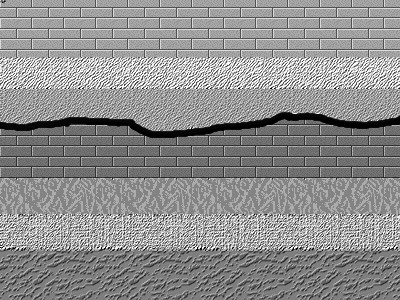|
Tierra Del Fuego Igneous And Metamorphic Complex
Tierra del Fuego Igneous and Metamorphic Complex is a geological basement complex known from boreholes in northern Tierra del Fuego. The complex is made up of foliated igneous rocks of Cambrian age including orthogneiss. It underlies unconformably the Jurassic Tobífera Formation. The protoliths of Cordillera Darwin Metamorphic Complex The Cordillera Darwin Metamorphic Complex is a geologic complex composed chiefly of metamorphic rocks located in southern Tierra del Fuego. It has been suggested that the Cordillera Darwin Metamorphic Complex is analogous to the Eastern Andes Me ... are unrelated to Tierra del Fuego Igneous and Metamorphic Complex despite present-day proximity. References Cambrian Argentina Cambrian Chile Geology of Magallanes Region Metamorphic complexes Lithodemic units of Argentina Lithodemic units of Chile {{geology-stub ... [...More Info...] [...Related Items...] OR: [Wikipedia] [Google] [Baidu] |
Complex (geology)
In geology Geology (). is a branch of natural science concerned with the Earth and other astronomical objects, the rocks of which they are composed, and the processes by which they change over time. Modern geology significantly overlaps all other Earth ..., a complex is a lithodemic unit consisting of two or more lithodemes of more than one genetic class ( metamorphic, igneous or sedimentary). The law of superposition is inapplicable to intrusive, highly deformed, or metamorphic bodies of rock lacking discernible stratification. Such bodies of rock are described as ''lithodemic'' and are determined and delimited based on rock characteristics. The 1983 North American Stratigraphic Code adopted the formal term ''lithodeme'', which is comparable to a formation. A lithodeme is the fundamental unit and should possess distinctive and consistent lithological features, comprising a single rock type or a mixture of two or more types that distinguishes the unit from those around i ... [...More Info...] [...Related Items...] OR: [Wikipedia] [Google] [Baidu] |
Unconformity
An unconformity is a buried erosional or non-depositional surface separating two rock masses or strata of different ages, indicating that sediment deposition was not continuous. In general, the older layer was exposed to erosion for an interval of time before deposition of the younger layer, but the term is used to describe any break in the sedimentary geologic record. The significance of angular unconformity (see below) was shown by James Hutton, who found examples of Hutton's Unconformity at Jedburgh in 1787 and at Siccar Point in Berwickshire in 1788, both in Scotland. The rocks above an unconformity are younger than the rocks beneath (unless the sequence has been overturned). An unconformity represents time during which no sediments were preserved in a region or were subsequently eroded before the next deposition. The local record for that time interval is missing and geologists must use other clues to discover that part of the geologic history of that area. The interval ... [...More Info...] [...Related Items...] OR: [Wikipedia] [Google] [Baidu] |
Metamorphic Complexes
Metamorphic rocks arise from the transformation of existing rock to new types of rock in a process called metamorphism. The original rock (protolith) is subjected to temperatures greater than and, often, elevated pressure of or more, causing profound physical or chemical changes. During this process, the rock remains mostly in the solid state, but gradually recrystallizes to a new texture or mineral composition. The protolith may be an igneous, sedimentary, or existing metamorphic rock. Metamorphic rocks make up a large part of the Earth's crust and form 12% of the Earth's land surface. They are classified by their protolith, their chemical and mineral makeup, and their texture. They may be formed simply by being deeply buried beneath the Earth's surface, where they are subject to high temperatures and the great pressure of the rock layers above. They can also form from tectonic processes such as continental collisions, which cause horizontal pressure, friction, and distort ... [...More Info...] [...Related Items...] OR: [Wikipedia] [Google] [Baidu] |
Geology Of Magallanes Region
Geology (). is a branch of natural science concerned with the Earth and other astronomical objects, the rocks of which they are composed, and the processes by which they change over time. Modern geology significantly overlaps all other Earth sciences, including hydrology. It is integrated with Earth system science and planetary science. Geology describes the structure of the Earth on and beneath its surface and the processes that have shaped that structure. Geologists study the mineralogical composition of rocks in order to get insight into their history of formation. Geology determines the relative ages of rocks found at a given location; geochemistry (a branch of geology) determines their absolute ages. By combining various petrological, crystallographic, and paleontological tools, geologists are able to chronicle the geological history of the Earth as a whole. One aspect is to demonstrate the age of the Earth. Geology provides evidence for plate tectonics, the evolutionary ... [...More Info...] [...Related Items...] OR: [Wikipedia] [Google] [Baidu] |
Cambrian Chile
The Cambrian ( ) is the first geological period of the Paleozoic Era, and the Phanerozoic Eon. The Cambrian lasted 51.95 million years from the end of the preceding Ediacaran period 538.8 Ma (million years ago) to the beginning of the Ordovician Period 486.85 Ma. Most of the continents lay in the southern hemisphere surrounded by the vast Panthalassa Ocean. The assembly of Gondwana during the Ediacaran and early Cambrian led to the development of new convergent plate boundaries and continental-margin arc magmatism along its margins that helped drive up global temperatures. Laurentia lay across the equator, separated from Gondwana by the opening Iapetus Ocean. The Cambrian marked a profound change in life on Earth; prior to the Period, the majority of living organisms were small, unicellular and poorly preserved. Complex, multicellular organisms gradually became more common during the Ediacaran, but it was not until the Cambrian that fossil diversity seems to rapidly increase ... [...More Info...] [...Related Items...] OR: [Wikipedia] [Google] [Baidu] |
Cordillera Darwin Metamorphic Complex
The Cordillera Darwin Metamorphic Complex is a geologic complex composed chiefly of metamorphic rocks located in southern Tierra del Fuego. It has been suggested that the Cordillera Darwin Metamorphic Complex is analogous to the Eastern Andes Metamorphic Complex. The Cordillera Darwin Metamorphic Complex is the only metamorphic complex in the southern Andes known to have amphibolite facies rocks containing kyanite and sillimanite which evidences high-grade metamorphism. High-grade metamorphism took place during the Cretaceous purportedly in association with the closure of the Rocas Verdes Basin. The protolith A protolith () is the original, unmetamorphosed rock from which a given metamorphic rock is formed. For example, the protolith of a slate is a shale or mudstone. Metamorphic rocks can be derived from any other kind of non-metamorphic rock and ...s of Cordillera Darwin Metamorphic Complex are unrelated to Tierra del Fuego Igneous and Metamorphic Complex despite prese ... [...More Info...] [...Related Items...] OR: [Wikipedia] [Google] [Baidu] |
Protolith
A protolith () is the original, unmetamorphosed rock from which a given metamorphic rock is formed. For example, the protolith of a slate is a shale or mudstone. Metamorphic rocks can be derived from any other kind of non-metamorphic rock and thus there is a wide variety of protoliths. Identifying a protolith is a major aim of metamorphic geology. Protoliths are non-metamorphic rocks and have no protoliths themselves. The non-metamorphic rocks fall into two classes: sedimentary rocks, formed from sediment, and igneous rocks, formed from magma. The source of the sediment of a sedimentary rock is termed its provenance Provenance () is the chronology of the ownership, custody or location of a historical object. The term was originally mostly used in relation to works of art, but is now used in similar senses in a wide range of fields, including archaeology, p .... Magmatic protoliths can be further divided into three categories: ultramafic rock, mafic rock, and quartzo- ... [...More Info...] [...Related Items...] OR: [Wikipedia] [Google] [Baidu] |
Jurassic
The Jurassic ( ) is a Geological period, geologic period and System (stratigraphy), stratigraphic system that spanned from the end of the Triassic Period million years ago (Mya) to the beginning of the Cretaceous Period, approximately 143.1 Mya. The Jurassic constitutes the second and middle period of the Mesozoic, Mesozoic Era as well as the eighth period of the Phanerozoic, Phanerozoic Eon and is named after the Jura Mountains, where limestone strata from the period were first identified. The start of the Jurassic was marked by the major Triassic–Jurassic extinction event, associated with the eruption of the Central Atlantic magmatic province, Central Atlantic Magmatic Province (CAMP). The beginning of the Toarcian Age started around 183 million years ago and is marked by the Toarcian Oceanic Anoxic Event, a global episode of Anoxic event, oceanic anoxia, ocean acidification, and elevated global temperatures associated with extinctions, likely caused by the eruption of the Kar ... [...More Info...] [...Related Items...] OR: [Wikipedia] [Google] [Baidu] |
Geological Society Of London
The Geological Society of London, known commonly as the Geological Society, is a learned society based in the United Kingdom. It is the oldest national geological society in the world and the largest in Europe, with more than 12,000 Fellows. Fellows are entitled to the postnominal FGS (Fellow of the Geological Society), over 2,000 of whom are Chartered Geologists (CGeol). The Society is a registered charity, no. 210161. It is also a member of the Science Council, and is licensed to award Chartered Scientist to qualifying members. The mission of the society is: "Making geologists acquainted with each other, stimulating their zeal, inducing them to adopt one nomenclature, facilitating the communication of new facts and ascertaining what is known in their science and what remains to be discovered". History The Society was founded on 13 November 1807 at the Freemasons' Tavern, Great Queen Street, in the Covent Garden district of London. It was partly the outcome of a previou ... [...More Info...] [...Related Items...] OR: [Wikipedia] [Google] [Baidu] |
Cambrian
The Cambrian ( ) is the first geological period of the Paleozoic Era, and the Phanerozoic Eon. The Cambrian lasted 51.95 million years from the end of the preceding Ediacaran period 538.8 Ma (million years ago) to the beginning of the Ordovician Period 486.85 Ma. Most of the continents lay in the southern hemisphere surrounded by the vast Panthalassa Ocean. The assembly of Gondwana during the Ediacaran and early Cambrian led to the development of new convergent plate boundaries and continental-margin arc magmatism along its margins that helped drive up global temperatures. Laurentia lay across the equator, separated from Gondwana by the opening Iapetus Ocean. The Cambrian marked a profound change in life on Earth; prior to the Period, the majority of living organisms were small, unicellular and poorly preserved. Complex, multicellular organisms gradually became more common during the Ediacaran, but it was not until the Cambrian that fossil diversity seems to rapidly ... [...More Info...] [...Related Items...] OR: [Wikipedia] [Google] [Baidu] |
Foliation
In mathematics (differential geometry), a foliation is an equivalence relation on an topological manifold, ''n''-manifold, the equivalence classes being connected, injective function, injectively immersed submanifolds, all of the same dimension ''p'', modeled on the manifold decomposition, decomposition of the real coordinate space R''n'' into the cosets ''x'' + R''p'' of the standardly embedding, embedded subspace topology, subspace R''p''. The equivalence classes are called the leaves of the foliation. If the manifold and/or the submanifolds are required to have a piecewise-linear manifold, piecewise-linear, differentiable manifold, differentiable (of class ''Cr''), or analytic manifold, analytic structure then one defines piecewise-linear, differentiable, or analytic foliations, respectively. In the most important case of differentiable foliation of class ''Cr'' it is usually understood that ''r'' ≥ 1 (otherwise, ''C''0 is a topological foliation). The number ''p'' (the dime ... [...More Info...] [...Related Items...] OR: [Wikipedia] [Google] [Baidu] |





